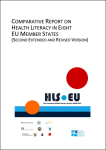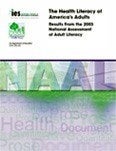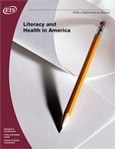The first analysis of population-based health literacy skills among adults was undertaken by Rudd, Kirsch, and Yamamoto (2004). Rudd developed a typology of health activities and coded all health-related items and tasks on adult literacy surveys. Referred to as the Health and Adult Literacy Survey (HALS), the coding and the latent class analyses model supported an approach to assessing skills of adults within and across countries. Several countries, such as Australia, Canada, the Netherlands and New Zealand, have used this coding schema to analyze population health literacy thus far (and more are underway).
Separately, the U.S. Department of Health and Human Services worked with the Department of Education to develop the National Assessment of Adult Literacy (NAAL), which included a purposive sample of materials and items (n=28) related to health.
Independently, the EU developed and conducted a survey of citizens’ perception of their health literacy. Several countries have participated in this survey thus far (and more are underway).
Overall, all reports indicate that health literacy is not independent of social factors and that population groups generally considered to be at risk for health issues (including the elderly, the poor, those without a high school degree, those who have limited resources, those who live in less resourced areas, and those who are members of minority populations) are also more likely to have limited health literacy proficiencies.
Health Literacy Population Assessments

Comparative Report on Health Literacy in Eight EU Member States
The European Health Literacy Survey project (HLS-EU) developed instruments for measuring perceived health literacy in Europe and documented the ways health literacy is operationalized in eight different national contexts.

The Health Literacy of America’s Adults: Results from the 2003 National Assessment of Adult Literacy
This analysis found that the average scores reported for the 2003 National Assessment of Adult Literacy (NAAL) health literacy measure are lower than are those for general literacy among adults. The conclusion reached is that large numbers of U.S. adults do not have health literacy skills that would enable them to effectively use health materials to accomplish challenging or complex health-related literacy tasks.

Literacy and Health in America
The HALS analysis offers evidence that average proficiencies in the U.S. are limited — on average, adults have difficulty performing health related tasks using health materials drawn from a broad spectrum of activities. Analyses indicate links between limited health literacy and compromised health status, limited engagement in civic activities, and reduced access to health information.



